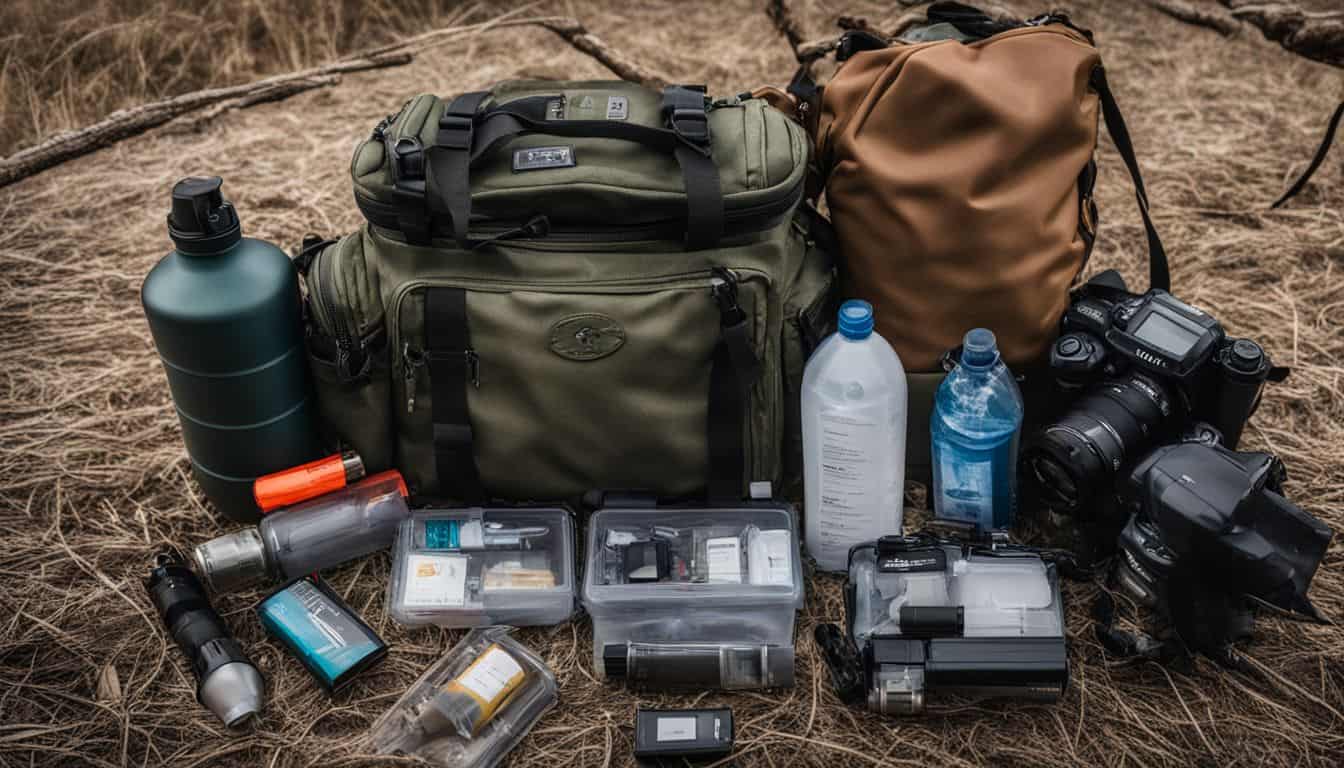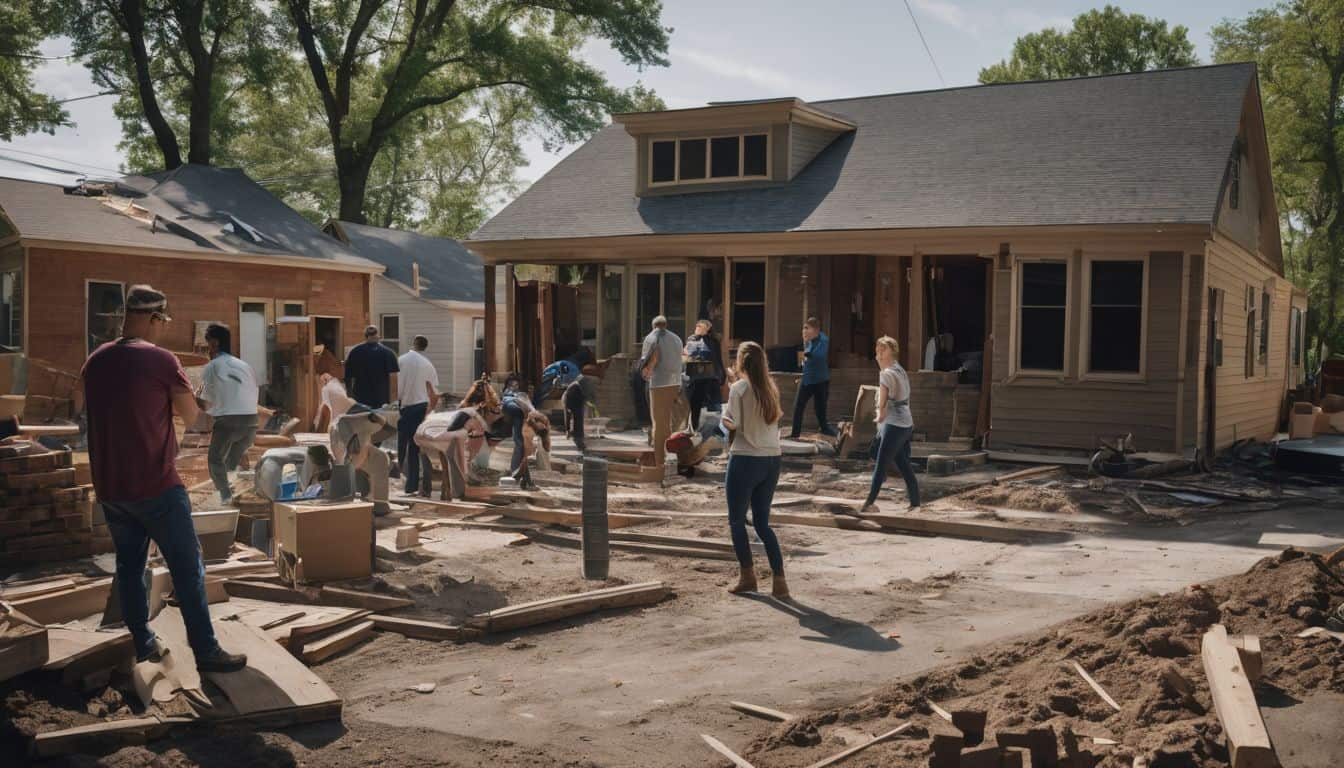Natural disasters can happen anytime, anywhere. It’s very important to have an evacuation plan ready for such events. This plan tells you where to go and what to do if a disaster hits.
Evacuation plans help keep everyone safe and save lives.
Creating a good plan starts with knowing what kind of disasters can hit your area. For example, people who live near the ocean need a plan in case of hurricanes or tsunamis. People living near mountains may have plans for landslides or wildfires.
The next step is coming up with many options for places to go during the evacuation.
It’s also key that this safety action happens fast! Each moment counts when danger is close by. So, make sure everybody knows about all exits from each room in your home and at work too!
Safety risks must be looked at as well while making this plan. Make sure the path out is clear at all times! It’s wise to take pictures of everything in your home too ahead of time just in case something happens!
Evacuation routes must lead you safely away from any harm caused by natural disasters like floods, fires or storms.
Finally, all family members should know where they can meet up once they are safe outside the impacted area.
Proper planning helps everyone keep calm during times of fear and stress caused by these unexpected events! That way everyone stays as safe as possible till help arrives! Life can get back normal sooner when we are prepared beforehand!
The Importance of Evacuation Plans for Natural Disasters
Evacuation plans for natural disasters are crucial as they ensure the safety of individuals and communities by providing a systematic approach to respond effectively to potential hazards.
Research and data collection
I always dig deep for facts and figures about natural disasters. Data gives a clear picture of the risks we face. It tells us what kind of disaster might happen and how bad it could be.
This research helps me plan better for safety during a crisis. For example, I found out that creating plans before an earthquake strikes can by itself lift our readiness levels high! One study shows the role of data even in big public evacuations involving over 1000 persons.
From start to finish, data and info are key parts of my preparation steps against disasters.
Creating a resource center
A resource center is a big help in planning for natural disasters. It gives useful data to make good evacuation plans. You can find different ways to get out when the bad times come, like going to a friend’s house or hotel far from danger.
The resource center insists everyone should talk about these plans ahead of time. This way, all family members know what to do when there is an earthquake or other dangerous event.
It also pushes people to ready emergency supplies before any disaster comes knocking at their door! So, it’s smart and safe to use a resource center as part of your safety measures against natural calamities.
Assessing safety risks
Assessing safety risks is a crucial step in creating effective evacuation plans for natural disasters. It involves carefully identifying potential hazards and evaluating the level of risk they pose to individuals and communities.
By conducting thorough research and data collection, we can gather valuable information about past disasters, local geographical features, and vulnerable populations. This helps us determine what safety precautions need to be taken and how emergency response can be better prepared.
By incorporating risk assessment into our evacuation procedures, we can ensure that everyone stays safe during a natural calamity.
Five Steps for Preparing an Effective Evacuation Plan
Preparing an effective evacuation plan involves arranging evacuation ahead of time, planning what to take, creating a home inventory, gathering important documents, and designating a meeting place outside the impacted area.
Find out more about these crucial steps for successful preparedness.
Arrange evacuation ahead of time
Arranging evacuation ahead of time is crucial for preparing an effective evacuation plan. It’s important to have a plan in place before a natural disaster strikes. Start by researching and gathering information about your area’s specific risks and evacuation routes.
Make sure this critical information is easily accessible to you and your family.
Next, create a checklist of what you’ll need to take with you during an evacuation, such as important documents, medications, and supplies. Keep this list handy so you can quickly gather these items when needed.
Don’t forget to create a home inventory, documenting your belongings with photos or videos. This can help with insurance claims later on if any damage occurs.
Plan what to take
When preparing an effective evacuation plan for natural disasters, one important step is to plan what to take. This means deciding which essential items and supplies you will need to bring with you when evacuating your home.
It’s crucial to prioritize the most necessary items like food, water, medications, clothing, and important documents. By making a list and gathering these items in advance, you can ensure that you have everything you need during the evacuation process.
Remember to also consider any specific needs of family members or pets when planning what to take.
Create a home inventory
One important step in preparing for a natural disaster evacuation is creating a home inventory. This means making a list of all your household possessions, like furniture, electronics, and valuable items.
It’s also a good idea to take pictures or videos of each item to provide visual documentation. Creating a home inventory helps you keep track of your belongings and can be useful when filing insurance claims after a natural disaster.
By having an accurate record of what you own, it will be easier to assess any losses and ensure that you have the right insurance coverage in place.
Gather important documents
One of the most crucial steps in preparing for an effective evacuation plan is gathering important documents. It’s essential to have all your essential paperwork in one place, easily accessible during an evacuation.
This includes items like identification papers, insurance policies, medical records, and financial documents. To ensure their safety, it’s recommended to keep these documents in a waterproof and fireproof box or folder.
Additionally, creating digital copies of these important documents and storing them securely either in the cloud or on an external hard drive is a wise precautionary measure. By taking these steps, you’ll have peace of mind knowing that your vital information is organized and easily accessible when you need it most.
Designate a meeting place outside the impacted area
When preparing an evacuation plan for a natural disaster, it’s important to designate a meeting place outside the impacted area. This is a specific location where family members can gather in case they get separated before or during the evacuation.
The meeting place should be easily recognizable and outside of the evacuation zone to ensure everyone’s safety. By choosing a predetermined spot, you can make sure that everyone knows where to go and can reunite without any confusion or delay.
Remember, the purpose of designating a meeting place is to keep your loved ones together and accounted for during this stressful time.
Important Fact:
– One of the steps for preparing an effective evacuation plan is to designate a meeting place outside the impacted area.
– The meeting place should be specific and easily recognizable for family members to gather.
The Role of Emergency Management in the Evacuation Process
Emergency management plays a crucial role in the evacuation process, from prevention and mitigation to response and recovery. Discover how their expertise can ensure a safe and successful evacuation.
Prevention and mitigation
Preventing and mitigating the impact of natural disasters is crucial in ensuring successful evacuation plans. As a survival enthusiast, it’s important to understand that emergency management involves various stages, including prevention and mitigation.
This means taking proactive measures to reduce risks and prevent disasters from happening in the first place.
By identifying potential hazards, conducting risk assessments, and implementing safety measures, we can greatly reduce the impact of natural disasters. For example, creating safe zones or barriers can help protect communities from flooding or landslides.
Developing early warning systems allows for timely evacuation when necessary.
Mitigation efforts also involve educating communities about disaster preparedness and providing resources for them to better cope with emergencies. By equipping ourselves with knowledge about evacuation routes, emergency supplies, and communication methods during a crisis, we increase our chances of staying safe.
Preparedness
Preparedness is a crucial aspect of natural disaster evacuation plans. It involves taking proactive steps to ensure your safety and the safety of your loved ones in case of an emergency.
This includes creating and sharing an evacuation plan with family members well in advance, arranging for necessary supplies and resources, and staying informed about potential risks.
Training people to respond effectively during emergencies is also vital. By prioritizing preparedness, you can better protect yourself and increase the chances of a successful evacuation if needed.
Response
In emergency management, the response phase is a crucial part of the evacuation process. It involves taking immediate action to protect people and provide assistance during natural disasters.
This includes activating emergency operations centers, evacuating those at risk, opening shelters, and offering mass care services. Effective communication plays a key role in this phase by providing alerts, evacuation instructions, and important information on self-protection measures.
It’s important to have a well-defined plan that includes contacts, evacuation routes, and guidance on how to respond during emergencies. By preparing ahead of time and having a shared plan with your family members, you can ensure safety during times of crisis.
Recovery
Recovery is a really important step after a natural disaster. It can take a long time to fully recover, sometimes even years or decades. The success of the evacuation process is closely connected to how well the recovery phase goes.
During recovery, emergency management plays a big role in coordinating resources, helping people and communities affected by the disaster, and assisting with rebuilding. People who are already vulnerable because they have less money or resources might need extra support during this time.
Developing a Robust Communications Strategy
To ensure effective communication during a natural disaster evacuation, it is crucial to establish an emergency control organization and determine escape routes and nearest exits.
Establishing an emergency control organization
To ensure effective communication during natural disaster evacuations, it is essential to establish an emergency control organization. This involves developing a robust communications strategy that includes designated forms of communication for different situations.
Public officials need to be prepared to deliver informative and reassuring messages to the public and media during emergencies. A disaster communication plan plays a vital role in distributing information and ensuring coordination during a crisis.
The National Emergency Communications Plan aims to enable secure communication and real-time information sharing across different technologies. By establishing an emergency control organization, we can better respond to emergencies and provide timely updates to keep everyone safe.
Determining escape routes and nearest exits
Determining escape routes and nearest exits is a key part of developing a strong communications strategy for natural disaster evacuation plans. Here are some important steps to take:
- Conduct a thorough assessment of the area: Research and analyze the geography, topography, and potential hazards in your community. This will help determine the best evacuation routes and identify safe locations.
- Evaluate existing infrastructure: Assess the condition of roads, bridges, tunnels, and other transportation systems in your area. Identify any weak spots or areas that may be prone to damage during a disaster.
- Collaborate with local authorities: Work closely with emergency management agencies, local law enforcement, and other relevant organizations to gather information about designated evacuation routes and safe zones. Determine the closest exits and access points for people to leave the affected area quickly and safely.
- Mark evacuation routes clearly: Ensure that evacuation routes are well-marked with clear signage and easy-to-understand instructions. Use reflective materials or lighting to make them visible even in low visibility conditions.
- Regularly update information: Keep track of any changes or updates made to evacuation routes or designated exits. Communicate these updates through various channels, such as community meetings, websites, social media platforms, and local news outlets.
Managing Traffic Congestion during Evacuations
Managing traffic congestion during evacuations is a crucial part of natural disaster evacuation plans. The goal is to make sure that vehicles and people can move safely and efficiently away from the dangerous area.
To do this, careful planning is needed to minimize cross traffic and keep the flow of evacuation moving smoothly. It’s also important to consider the needs of special populations, like those with disabilities or who may need extra assistance during an evacuation.
Creating a coordination framework and having a strong communications strategy are key elements in successfully managing traffic congestion during evacuations. This includes things like establishing clear evacuation routes, coordinating with local authorities for traffic control, and considering different transportation options.
By thinking ahead and preparing for how to manage traffic congestion, we can help ensure that evacuations proceed as smoothly as possible during times of natural disasters.
Account for Multimodal Transportation
Multimodal transportation planning is important when creating evacuation plans for natural disasters. It means considering different ways people can travel, like walking, biking, or using public transit.
Integrating these modes of transportation into the plan helps ensure that everyone can evacuate safely and efficiently. Having pedestrian-friendly infrastructure, cycling routes, and reliable public transportation systems in place is crucial for emergency preparedness and disaster response.
During a disaster, it’s important to coordinate with transportation agencies to mobilize resources and distribute relief effectively. By accounting for multimodal transportation options, we can better handle emergencies and provide support to those affected by natural disasters.
The Importance of Regular Training and Drills
Regular training and drills are essential for ensuring preparedness in the event of a natural disaster. These exercises help individuals practice the actions they will take before, during, and after an emergency.
By participating in these drills, responders and facility personnel can become familiar with emergency procedures and improve coordination. Regular training and drills also play a crucial role in validating existing emergency plans, programs, policies, roles, responsibilities, and training curriculum.
They enhance confidence by allowing individuals to fulfill their responsibilities effectively during a real emergency. Disaster education through regular training creates a proactive approach towards risk management while ensuring that everyone involved is well-prepared to respond swiftly and efficiently when it matters most.
How to Adapt Evacuation Plans for Different Natural Disasters
Adapting evacuation plans for different natural disasters is really important. Here are some ways to do it:
- Map out primary and backup routes to evacuation destinations.
- Have a physical map of the area for guidance during evacuation.
- Designate a meeting place outside the impacted area for family members to gather during an emergency.
- Include specific procedures in your evacuation plans for different types of natural disasters.
- Modify your evacuation plans based on the specific characteristics of each natural disaster.
Conclusion on Natural Disaster Evacuation Plans
In conclusion, preparing an effective natural disaster evacuation plan is crucial for ensuring the safety of yourself and your loved ones. By arranging the evacuation ahead of time, planning what to take, creating a home inventory, gathering important documents, and designating a meeting place outside the affected area, you can be better prepared for any emergency.
Remember to also consider the role of emergency management in the evacuation process and develop a robust communications strategy. Regular training and drills can further enhance your preparedness.
Stay safe!
FAQs on Natural Disaster Evacuation Plans
1. Why do I need a natural disaster evacuation plan?
Having a natural disaster evacuation plan is important to ensure the safety and well-being of yourself and your loved ones during emergencies. It helps you navigate potential risks, escape dangerous situations, and find shelter or resources in times of crisis.
2. What should be included in a natural disaster evacuation plan?
A comprehensive natural disaster evacuation plan should include details such as emergency contact information, designated meeting points for family members, routes to safe locations or shelters, essential supplies to pack, and any specific considerations for individuals with special needs.
3. How often should I review and update my natural disaster evacuation plan?
It is recommended to review and update your natural disaster evacuation plan at least once a year or whenever there are significant changes in your household or living situation. This ensures that the plan remains relevant and effective.
4. Is it necessary to practice the evacuation plan regularly?
Yes, practicing your natural disaster evacuation plan regularly is crucial for its effectiveness. By conducting drills or simulations, you can identify any weaknesses or challenges in executing the plan, improve response times, familiarize everyone with their roles and responsibilities, and build confidence in handling emergencies.
5. Should I rely solely on official notifications during a natural disaster?
While official notifications from local authorities are important sources of information during emergencies, it’s advisable not to rely solely on them. Having an established communication network within your household or community enables you to stay updated on developments that may affect your safety more immediately or provide additional guidance beyond general alerts issued by authorities.






Leave a Reply